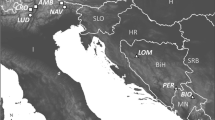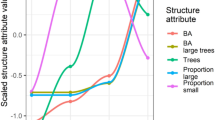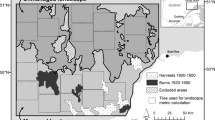Abstract
Uneven-aged silver fir-European beech forest stands were studied to (1) analyse the dynamics of diameter structure and tree species composition in the past two centuries and (2) determine the impact of red deer on the regeneration and recruitment of silver fir. The study used current data on forest stands, archival data from old forest management plans for the period 1789–2004, and red deer harvesting records for the period 1907–2006. During the observation period, the silver fir population aged and silver fir and European beech alternated in dominance. The study revealed a strong impact of red deer on the composition and recruitment of tree regeneration, especially on silver fir regeneration. The drastic changes in red deer density (from extermination up to 5.8 animals km−2) and past forest management practices were apparently the main factors driving the population dynamics of silver fir (regeneration, recruitment, and diameter structure) in the study area during the past two centuries.



Similar content being viewed by others
References
Adamic M (1992) Red deer management (Cervus elaphus L.) in Republic Slovenia: the problems, recent trends and perspectives. Zbornik gozdarstva in lesarstva 39:47–60
Agnoletti M, Anderson S (eds) (2000) Methods and approaches in forest history. CABI Publishing, Wallingford
Ammer C (1996) Impact of ungulates on structure and dynamics of natural regeneration of mixed mountain forests in the Bavarian Alps. For Ecol Manag 88(1–2):43–53
Axelsson AL, Ostlund L, Hellberg E (2002) Changes in mixed deciduous forests of boreal Sweden 1866–1999 based on interpretation of historical records. Landscape Ecol 17(5):403–418
Bigler C, Gricar J, Bugmann H, Cufar K (2004) Growth patterns as indicators of impending tree death in silver fir. For Ecol Manag 199:183–190
Boncina A (1999) Stand dynamics of the virgin forest Rajhenavski Rog (Slovenia) during the past century. In: Diaci J (ed) Virgin forests and forest reserves in Central and East European countries: history, present status and future development: proceedings of the invited lecturers’ reports presented at the COST E4 management committee and working groups meeting in Ljubljana, Slovenia. Biotechnical faculty, Department of Forestry and Renewable Forest Resources, Ljubljana, pp 95–110
Boncina A (2000) Comparison of structure and biodiversity in the Rajhenav virgin forest remnant and managed forest in the Dinaric region of Slovenia. Glob Ecol Biogeogr 9:201–211
Boncina A, Diaci J, Cencic L (2002) Comparison of the two main types of selection forests in Slovenia: distribution, site conditions, stand structure, regeneration and management. Forestry 75(4):365–373
Boncina A, Gaspersic F, Diaci J (2003) Long-term changes in tree species composition in the Dinaric mountain forests of Slovenia. Forestry Chron 79(2):227–232
Cavlovic J (2000) Novi program gospodarenja za G.J. Belevine (2000–2009)—zaustavljanje nepovoljnih trendova i iniciranje povoljnih procesa u razvoju preborne sume? Sumarski list 124(7–8):450–457
Cavlovic J, Bozic M, Boncina A (2006) Stand structure of an uneven-aged fir-beech forest with an irregular diameter structure: modeling the development of the Belevine forest, Croatia. Eur J For Res 125:325–333
Chapman RA, Heitzman E, Shelton MG (2006) Long-term changes in forest structure and species composition of an upland oak forest in Arkansas. For Ecol Manag 236(1):85–92
Debeljak M, Dzeroski S, Adamic M (1999) Interactions among the red deer (Cervus elaphus L.) population, meteorological parameters and new growth of the natural regenerated forest in Sneznik, Slovenia. Ecol Model 121:51–61
Diaci J (2006) Gojenje gozdov: pragozdovi, sestoji, zvrsti, nacrtovanje, izbrana poglavja (in Slovene). Biotechnical faculty, Department of Forestry and Renewable Forest Resources, Ljubljana
Duchesne L, Ouimet R, Moore JD, Paquin R (2005) Changes in structure and composition of maple-beech stands following sugar maple decline in Quebec, Canada. For Ecol Manag 208(1–3):223–236
Fabjan I (1956) Snezniska jelenjad. Lovec 39(6):161–169
Ficko A, Boncina A (2006) Silver fir (Abies alba Mill.) distribution in Slovenian forests. Zbornik gozdarstva in lesarstva 79:19–35
FMP (1912) Betriebseinrichtung für das Dezennium 1912–1921. Reviere Schneeberg, Leskova dolina, Masun, Georgstal (in German)
FMP (1936) Forest management plan for FMU Leskova dolina 1936 (in Italian)
FMP (1954) Forest management plan for FMU Leskova dolina 1954–1963 (in Slovene)
FMP (1964) Forest management plan for FMU Leskova dolina 1964–1973 (in Slovene)
FMP (1974) Forest management plan for FMU Leskova dolina 1974–1983 (in Slovene)
FMP (1994) Forest management plan for FMU Leskova dolina 1994–2003 (in Slovene)
FMP (2004) Forest management plan for FMU Leskova dolina 2004–2013 (in Slovene)
Frelich LE, Lorimer CG (1985) Current and predicted long-term effects of deer browsing in hemlock forests in Michigan, USA. Biol Conserv 34(2):99–120
Gaspersic F (1967) Razvojna dinamika mesanih gozdov jelke-bukve na Snezniku v zadnjih sto letih (in Slovene). Gozdarski vestnik 7–8:202–237
Gaspersic F (1974) Zakonitosti naravnega pomlajevanje jelovo-bukovih gozdov na visokem krasu Sneznisko-Javorniskega masiva: doctoral dissertation (in Slovene). Biotechnical faculty, Department of Forestry and Renewable Forest Resources, Ljubljana
Gill RMA (1992a) A review of damage by mammals in north temperate forests. 1. Deer. Forestry 65(2):145–169
Gill RMA (1992b) A review of damage by mammals in north temperate forests. 3. Impact on trees and forests. Forestry 65(4):363–388
Heuze P, Schnitzler A, Klein F (2005) Consequences of increased deer browsing winter on silver fir and spruce regeneration in the Southern Vosges Mountains: implications for forest management. Ann For Sci 62(2):175–181
Hollander M, Wolfe DA (1999) Non-parametric statistical methods, 2nd edn. Wiley, New York
Hufnagl L (1893) Der Plenterwald, sein Normalbild, Holzvorrat, Zuwachs und Ertrag. Österr Vierteljahresschr Forstwes 117–132
Jarni K, Robic D, Boncina A (2004) Analysis of the influece of ungulates on the regeneration of Dinaric fir-beech forests in the research site Trnovec in the Kocevje forest management region. Zbornik gozdarstva in lesarstva 74:141–164
Jerina K (2006) Spatial distribution, home range and body mass of red deer (Cervus elaphus L.) in regard to environmental factors: doctoral dissertation (in Slovene). Biotechnical faculty, Department of Forestry and Renewable Forest Resources, Ljubljana
Jerina K (2008) Velika rastlinojeda divjad in razvojna dinamika gozdnih ekosistemov: proucevanje vplivov izbranih okoljskih in populacijskih parametrov ter gozdno-gojitvenih sistemov na zmoznosti naravne obnove: zakljucno porocilo o rezultatih opravljenega raziskovalnega dela na projektu v okviru ciljnega raziskovalnega projekta (CRP) “Konkurencnost Slovenije 2006–2013”: Research report. Biotechnical faculty, Department of Forestry and Renewable Forest Resources, Ljubljana
Johann E (2007) Traditional forest management under the influence of science and industry: the story of the alpine cultural landscapes. For Ecol Manag 249(1–2):54–62
Korpel S (1995) Die Urwälder der Westkarpaten. Gustav Fisher Verlag, Stuttgart
Krofel M, Kos I, Linnell J, Odden J, Teurlings I (2008) Human kleptoparasitism on Eurasian lynx (Lynx lynx L.) in Slovenia and Norway. Varstvo narave 21:93–103
Larsen JB (1995) Ecological stability of forests and sustainable silviculture. For Ecol Manag 73(1–3):85–96
Linder P (1998) Structural changes in two virgin boreal forest stands in central Sweden over 72 years. Scand J For Res 13(4):451–461
Linder P, Östlund L (1998) Structural changes in three mid-boreal Swedish forest landscapes, 1885–1996. Biol Conserv 85(1–2):9–19
Montes F, Sánchez M, del Rio M, Canellas I (2005) Using historic management records to characterize the effects of management on the structural diversity of forests. For Ecol Manag 207(1–2):279–293
Moore PD, Webb JA, Collinson ME (1997) Pollen analysis. Blackwell, London
Motta R (1996) Impact of wild ungulates on forest regeneration and tree composition of mountain forests in the Western Italian Alps. For Ecol Manag 88(1–2):93–98
O’Hara KL, Hasenauer H, Kindermann G (2007) Sustainability in multi-aged stands: an analysis of long-term plenter systems. Forestry 80:163–181
Oliver CD, Larsen BC (1996) Forest stand dynamics. Wiley, New York
Ott E (1989) Verjüngungsprobleme in hochstaudenreichen Gebirgsnadelwäldern. Schweizerische Zeitung Forstwes 140(1):23–42
Perko F (2002) Zapisano v branikah: Gozdovi in gozdarstvo od Sneznika do Nanosa skozi cas. Gozdarsko drustvo Postojna, Postojna
Petit CC, Lambin EF (2002) Long-term land -cover change in the Belgian Ardennes (1775–1929): model-based reconstruction vs. historical maps. Glob Change Biol 8:616–630
Pickett ST, White PS (1985) The ecology of natural disturbance of natural patch dynamics. Academic Press, San Diego
Pintaric K (1978) Urwald Perucica als natürliches Forschungslaboratorium. Allgemeine Forst Zeitschrift 24:702–707
Prpic B, Matic S, Vukelic J, Seletkovic Z (2001) Virgin forests of beech and fir in the Croatian Dinaric Mountain range. In: Prpic B (ed) Silver fir (Abies alba Mill.) in Croatia. Akademija sumarskih znanosti, Hrvatske sume, p.o. Zagreb, Zagreb, Croatia, pp 479–500
Putman RJ (1996) Ungulates in temperate forest ecosystems: perspectives and recommendations for future research. For Ecol Manag 88(1–2):205–214
Rabotnov TA (1992) Phytozönologie: Struktur und Dynamik natürlicher Ökosysteme. Verlag Eugen Ulmer, Stuttgart
Radeloff VC, Mladenoff DJ, He HS, Boyce MS (1999) Forest landscape change in the northwestern Wisconsin Pine Barrens from pre-European settlement to the present. Can J For Res 29(11):1649–1659
Roseberry JL, Woolf A (1991) A comparative evaluation of techniques for analyzing white-tailed deer harvest data. Wildlife monographs 117
Schollmayer H (1906) Direktiven für die Bestandesaufnahme und die Betriebseinrichtung auf der F.C. Herrschaft Schneeberg. Kleinmayr—Bamberg, Ljubljana
Schütt P, Weisberger H, Lang UM, Roloff A, Stimm B (1999) Abies alba Miller, 1768. In: Schütt P, Roloff A (eds) Enzyclopädie der Holzgewächse: Handbuch und Atlas der Dendrologie, 16. Ergänzungslieferung. Wiley-VCH, Weinheim
Schütz JP (2001) Der Plenterwald und weitere Formen strukturierter und gemischter Wälder. Parey, Berlin
Schweingruber FH (1996) Tree rings and environment. Dendroecology. Swiss Federal Institute for Forest, Snow Landscape Research, Birmensdorf, Paul Haupt Verlag, Berne
Senn J, Suter W (2003) Ungulate browsing on silver fir (Abies alba) in the Swiss Alps: beliefs in search of supporting data. For Ecol Manag 181(1–2):151–164
Sercelj A (1996) The origins and development of forests in Slovenia. Slovenska akademija znanosti in umetnosti, Ljubljana
Simak M (1951) Untersuchungen über den naturlichen Bauartenwechsel in der schweizerischen Plenterwälder. Mitteilungen Eidgenosischen Anstalt für Forstlichen Versuchswessen 27:406–468
Smith DW, Drummer TD, Murphy KM, Guernsey DS, Evans SB (2004) Winter prey selection and estimation of wolf kill rates in Yellowstone National Park, 1995–2000. J Wild Manag 68:153–166
Swetnam TW, Allen CD, Betancourt JL (1999) Applied historical ecology: using the past to manage for the future. Ecol Appl 9:1189–1206
van der Maarel E (2005) Vegetation ecology. Blackwell, Malden
Veselic Z (1991) Na Postojnskem prestevilna divjad se naprej hudo ogroza gozdno mladje. Gozdarski vestnik 49:147–157
Vrska T, Adam D, Hort L, Kolár T, Janík D (2009) European beech (Fagus sylvatica L.) and silver fir (Abies alba Mill.) rotation in the Carpathians—a developmental cycle or a linear trend induced by man? For Ecol Manag 258(4):347–356
Webb NF, Hebblewhite M, Merrill EH (2008) Statistical methods for identifying wolf kill sites using global positioning system locations. J Wild Manag 72:798–807
Author information
Authors and Affiliations
Corresponding author
Additional information
Communicated by C. Ammer.
Rights and permissions
About this article
Cite this article
Klopcic, M., Jerina, K. & Boncina, A. Long-term changes of structure and tree species composition in Dinaric uneven-aged forests: are red deer an important factor?. Eur J Forest Res 129, 277–288 (2010). https://doi.org/10.1007/s10342-009-0325-z
Received:
Revised:
Accepted:
Published:
Issue Date:
DOI: https://doi.org/10.1007/s10342-009-0325-z




